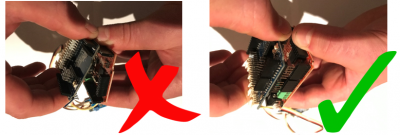Difference between revisions of "HANcoder/Training Material/AutomaticLightControlSystem"
DJSlofstra (talk | contribs) (→Goal of the tutorial) |
|||
| (8 intermediate revisions by 2 users not shown) | |||
| Line 1: | Line 1: | ||
| + | =LED Control System= | ||
| − | |||
== Goal of the tutorial == | == Goal of the tutorial == | ||
| − | The goal of this tutorial is to get used to the software tools that are being used to program a microcontroller that works in a model based development environment. Besides experiencing the merits of | + | The goal of this tutorial is to get used to the software tools that are being used to program a microcontroller that works in a model based development environment. Besides experiencing the merits of MATLAB Simulink®, HANcoder and HANtune, you will learn the meaning of analog voltages with regards to sensors. You will also learn about the use of PWM to regulate the intensity of an LED. |
After this tutorial you should be able to: | After this tutorial you should be able to: | ||
| Line 11: | Line 11: | ||
*Make a basic control system | *Make a basic control system | ||
| − | == | + | == Contents == |
| − | + | *Part 1: [[/1| The things you'll need]] | |
| − | + | *Part 2: [[/2| Adding analog signals and making them visible in HANtune]] | |
| − | + | *Part 3: [[/3| Compiling the model and flashing it onto the Olimexino]] | |
| − | * | + | *Part 4: [[/4| Using HANtune to visualize signals]] |
| − | * | + | *Part 5: [[/5| Adding an output to the model]] |
| − | + | *Part 6: [[/6| Connecting the input to the output]] | |
| − | + | *Part 7: [[/7| Making a control system]] | |
| − | |||
| − | * | ||
| − | |||
| − | * | ||
| − | * | ||
| − | |||
| − | |||
| − | |||
| − | |||
| − | |||
| − | |||
| − | [[ | ||
Latest revision as of 14:18, 31 May 2018
LED Control System
Goal of the tutorial
The goal of this tutorial is to get used to the software tools that are being used to program a microcontroller that works in a model based development environment. Besides experiencing the merits of MATLAB Simulink®, HANcoder and HANtune, you will learn the meaning of analog voltages with regards to sensors. You will also learn about the use of PWM to regulate the intensity of an LED.
After this tutorial you should be able to:
- Read in analog inputs
- Send out PWM signals
- Visualize signals and parameters within HANtune
- Make a basic control system
Contents
- Part 1: The things you'll need
- Part 2: Adding analog signals and making them visible in HANtune
- Part 3: Compiling the model and flashing it onto the Olimexino
- Part 4: Using HANtune to visualize signals
- Part 5: Adding an output to the model
- Part 6: Connecting the input to the output
- Part 7: Making a control system
